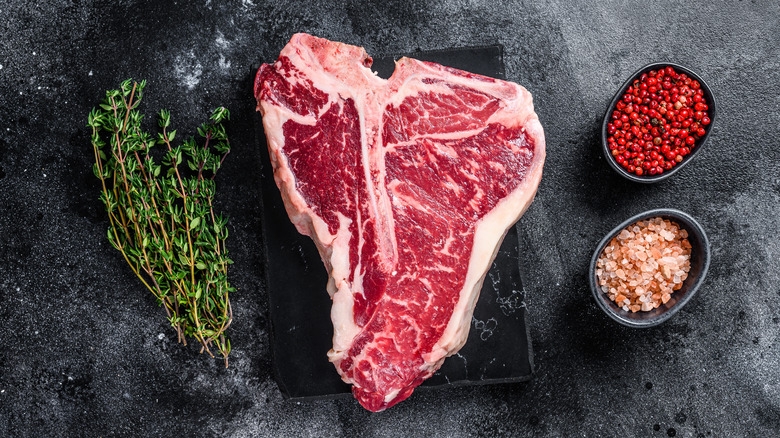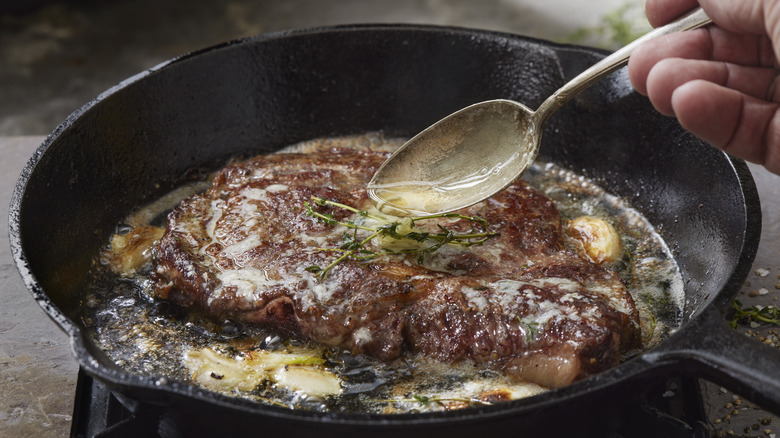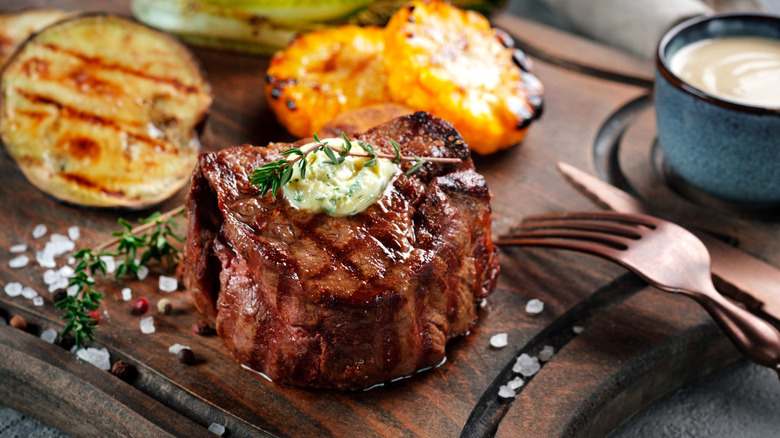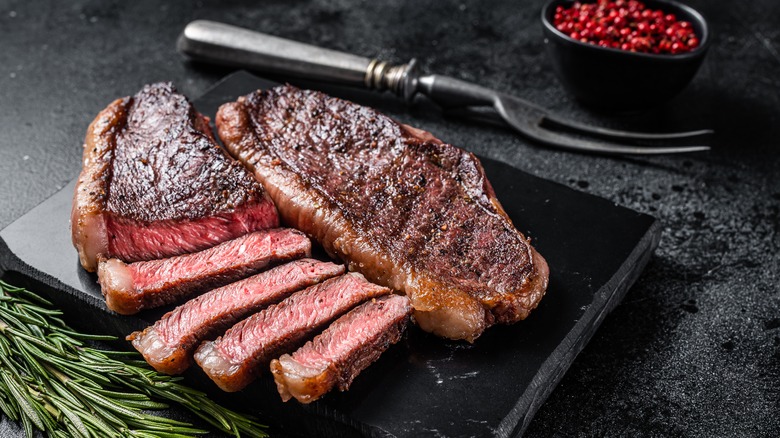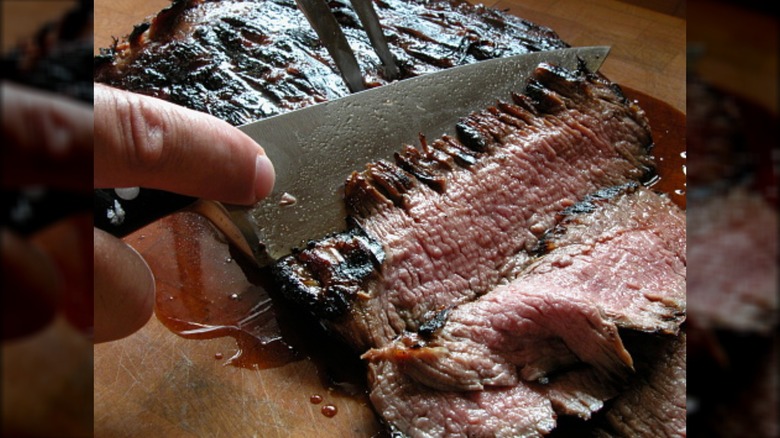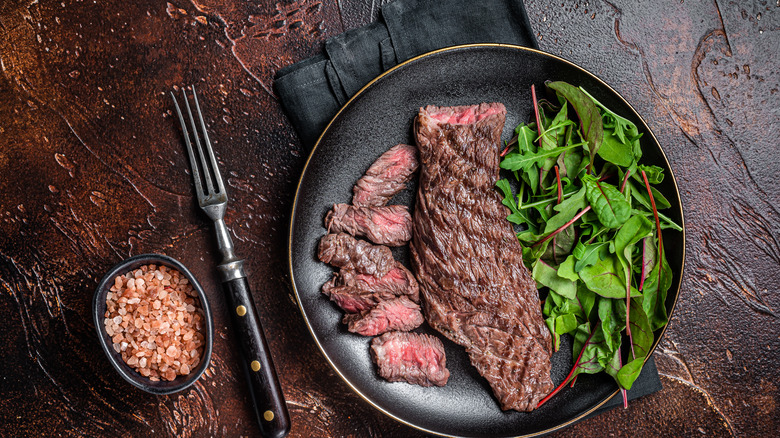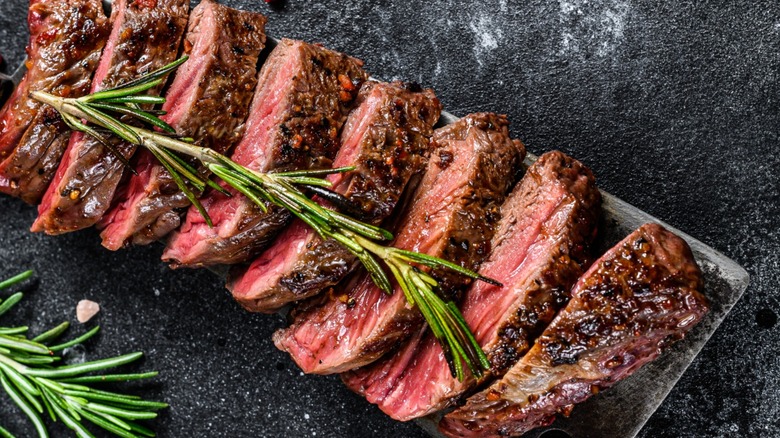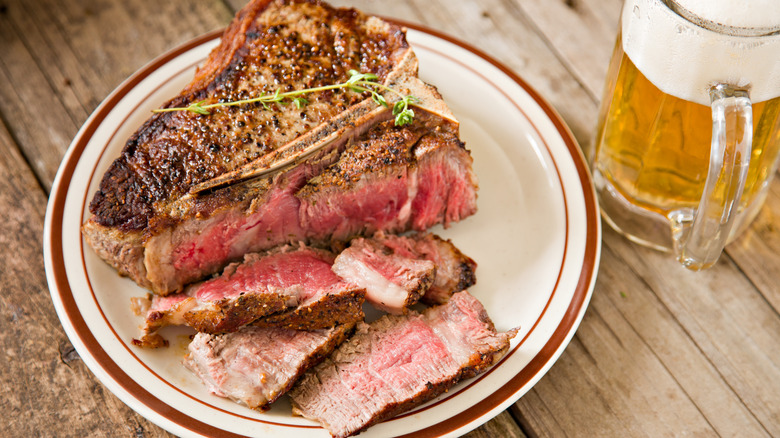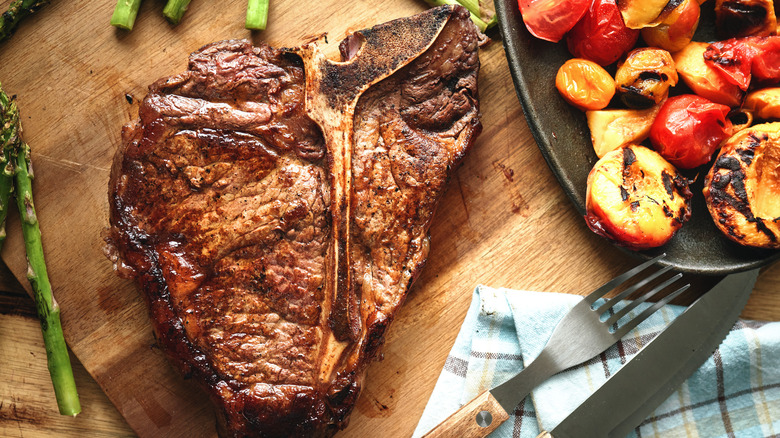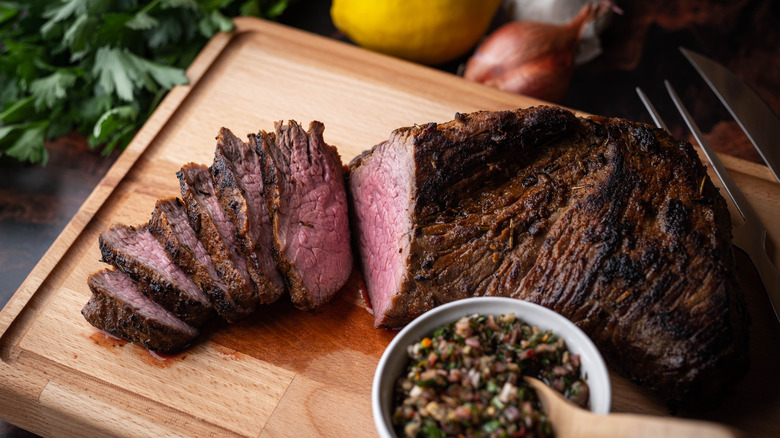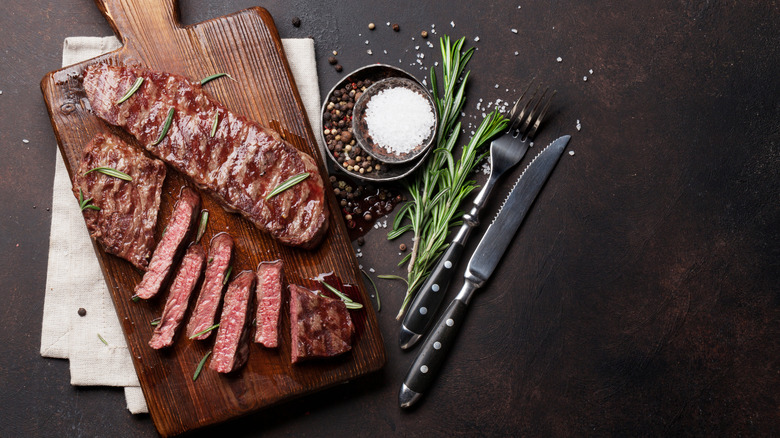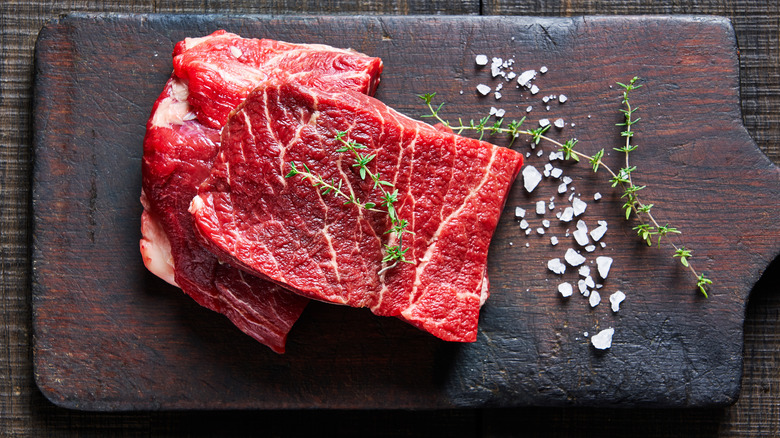These Are The Best Cuts Of Steak, According To Chefs
What could be better than a tender, juicy steak? Serving up a perfectly grilled steak along with roasted vegetables, buttery potatoes, smoky steak sauce, and a glass of red wine is dinner at its finest. But not all steak is created equal. Whether you're dining out or cooking for yourself, you want to make sure you're getting the best cut of steak possible and avoid the disappointment of tough, lackluster meat.
Exactly which cut of steak is the best is a highly contentious topic. Many claim ribeye reigns supreme, while others prefer ultra-tender filet mignon or supersized porterhouse. And plenty of other delicious cuts are often overlooked, such as tri-tip and flank steak. Which of these steak cuts is best is partially down to personal taste, the occasion, and how the meat is prepared. But, by consulting chefs, butchers, and other beef experts, we've compiled a list of the 11 best steak cuts and how to prepare them so you can choose the perfect steak for you.
Ribeye
Ribeye is always going to be a top contender when it comes to crowning the best steak. As the name implies, this cut comes from the cow's beef rib. It's a particularly prized portion of the meat because of its rich beefy flavor and the fat marbling throughout the meat. Because of its natural flavor and fat content, you can make the perfect, mouthwatering steak dinner using ribeye steak. To get the best flavor from this popular cut of meat, you'll need to cook it properly. Jeremy Pike, author and recipe creator at Angry BBQ, shared his preferred method. "If you've got a ribeye that is less than two inches thick, you can cook it over high heat," he said. You can do this on the grill for a nice sear. He went on to recommend that for thicker ribeye, you should reverse-sear it. "That can be done in an oven set to 250 F or on a smoker. You'll cook it until around 5 F shy of your target internal temperature, then sear it to get a beautiful crust."
One drawback to the ribeye is because it's such a delicious portion of the cow, it often comes at a premium price. If you're looking for a similar juicy flavor without paying that much, Butcher Kai Borghensen of Walden Local Meat recommends purchasing Delmonico steak. "This cut is the next up the shoulder from the ribeye and very similar aside from being slightly tougher than its higher priced relative," Borghensen explained to Chowhound.
Filet mignon
Even the name, filet mignon, sounds like a luxury dinner. This is a small cut of meat taken from the end of the tenderloin. But, while filet mignon is petite, it has a big reputation for being one of the best steaks. Filet mignon is known for its unbelievably tender texture. It doesn't have a lot of connective tissue or muscle fiber that makes meat tough. So, it's easy to slice through and enjoy the tender bites of mild, juicy meat.
Dan Kaplan is the founder of Hearthstone Farm, where he raises grass-fed beef, earning himself the title of 2023 Maine Beef Producer of the Year. When speaking to Chowhound about the best steak cuts, Kaplan named filet mignon as the best choice when you want your meal to be special. "If you want to impress, and it's an important night (maybe you're planning to propose!), the best steak would definitely be a filet mignon — guaranteed to impress with its tenderness (cut with a fork) and flavor," Kaplan said.
You can, of course, order filet mignon at a nice restaurant to get a chef-quality version of the famous meat, but it's also quite easy to prepare at home. Jeremy Pike's recommendation? "Pan-searing it to get a beautiful crust and then finishing it in an oven preheated to 350 F. You want to cook it to an internal temperature of 130 F," he explained. This method ensures you won't overcook and dry out the tender meat.
Sirloin steak
It may surprise some to see sirloin steak making the list of top steak cuts. This isn't always the most popular, as sirloin gets a bad rap for having a tough and chewy texture. Sirloin comes from the top of the cow's back, which doesn't contain much fat. Because of this, it has a tougher texture than portions of meat coming from fatty parts of the cow, such as ribeye or tenderloin. But that does not mean you should overlook this cut of steak. What sirloin lacks in fat marbling, it makes up for with its deep, beefy flavor. On top of that, being a leaner cut of meat makes it a great option for anyone trying to eat healthier. You can cut back on the excess fat you'd be getting in other beef cuts while still digging into a delicious steak.
The key to enjoying the flavor of sirloin steak is to prepare it properly. Dan Kaplan, the founder and farmer of Hearthstone Farm, recommends sirloin as a great marinating steak. It's true that if you just grill sirloin as it is, it can become chewy and tough. But, if you take the time to marinate the beef, it will maintain its juicy flavor and not dry out during cooking. Kaplan suggested enjoying sirloin for a weeknight meal, which you can marinate overnight before cooking and serving. "They'll pack plenty of flavor and make all the kids (even the grownups) happy," he told Chowhound.
Bavette steak or flank steak
Bavette steak and flank steak are often referred to interchangeably as both come from the abdominal area of the cow and have large grains and a strong, meaty flavor. Between the two, bavette steak is considered more desirable as it's larger and has more fat marbling, giving it a slightly more juicy flavor than flank steak. Praising bavette steak, butcher Kai Borghesan said it's one of her personal favorite cuts. "The loose grain adds great aeration to the meat, and decent fat marbling further enhances the flavor," she explained. "As a butcher in a whole animal shop, taking home a steak for myself is almost always between the bavette or the Denver. I really can't give a better endorsement than what ends up on my plate."
Although bavette steak will give you a slightly higher quality than flank steak, flank steak is still an excellent cut. If you're on a budget or want a leaner cut of meat, flank steak makes a great alternative with a similar flavor. "Readily available, fairly lean, and with only a medium toughness, flank steak is deservedly popular," Borghesan said. "The largest draw to the flank over [bavette] is its availability ... this steak is a staple that can be found in abundance at most supermarkets." So, when it comes to more casual dining, you may opt for flank steak over bavette.
Hanger steak
When listing the best cuts of steak, one that's commonly forgotten but should make it near the top of the list is hanger steak, also known as butcher's steak. Hanger steak is known for both its amazing flavor and its texture. "For most chefs, the hanger steak is the most revered but underrated and highly flavorful cut. It is tender, with a loose grain, and is prized for its robust, beefy flavor," Chef Brian Kennet told Chowhound. He advised cooking hanger steak to medium-rare or medium doneness and slicing thinly against the grain to enjoy this flavorful steak at its best.
The main drawback to this cut is simply that there needs to be more. Hanger steak is a thin piece of meat coming from the cow's belly. It's usually only about a pound of meat. Speaking to Chowhound, Kai Borghesan lamented how hard it is to get your hands on hanger steak. "This steak is amazing but small and hard to find," she explained. "Its location means that the standard way of breaking beef can often destroy this cut, and since each animal houses a pound or less of hanger, what does survive can go quickly. If you see this steak and don't have any company for dinner tonight, grab it and run. And pay. But then run like Charlie Bucket with a golden ticket."
Denver steak
Another contender for the best steak is the Denver steak. It comes from the chuck primal cut near the shoulder. Meat from this area is known for its deep flavor. Denver steak is a fairly new addition to menus, only getting its name in the early 2000s when a study claimed to have found this exciting new cut of beef. Denver steak is a good choice for flavor and has plenty of fat throughout the muscle that will melt into the meat as it cooks, resulting in a beautifully tender beef.
Kita Roberts, owner of Girl Carnivore, recommends selecting Denver Steak when you need a meal to impress. "This square-cut steak packs a ton of big flavor and nice marbling without the [excess] fat that often comes with a ribeye steak," she explained.
Kai Borghesan also suggested getting Denver steak as an easy-to-prepare and affordable steak dinner. "You'll almost always see it cut into single-serving-sized rectangles. This even sizing makes it easy to produce a very rare steak, even on the grill," Borghesan said. Because Denver steak is relatively thin, you can cook it over high heat quickly and get a beautiful sear without drying it out. "I consider this one of the best value steaks on an animal," Borghesan continued. "You'll be buying an experience fairly close to a ribeye, usually at about two-thirds the cost."
Porterhouse steak
Porterhouse steak is often referred to as the king of steaks. Just looking at the impressive cut makes it clear how it got its title. This large and thick portion of meat gives you two steaks for the price of one. There's a bone separating two sections of this steak cut. On one side, you have succulent tenderloin meat; on the other, you get top loin. Because of this, you essentially get tender filet mignon and strip steak all in one large cut of delicious steak. Due to its size, porterhouse steak is best shared between two people. Not only is it essentially two steaks combined, but it's a very thick and rich cut of meat. Even steak lovers will struggle to finish a porterhouse on their own.
When it comes to the best cut of steak, porterhouse, and ribeye are often put at the top of the list, and they're go-to orders at steakhouses everywhere. In a video for FOGO Charcoal, walking through his process of grilling the perfect porterhouse steak, Ron Dimpflmaier praised the king of steak for the amazing flavor it offers. "New York steak, filet mignon, the best of both worlds all in one steak, does it get any better? I don't think so," Dimpflmaier said.
T-bone steak
T-bones are quickly recognizable because of the t-shaped bone in the middle of the meat. That bone separates the tenderloin and the strip steak. Ordering a T-bone gives you both the loin and strip in one, making it a great option for big meat-eaters.
Porterhouse steak also includes New York strip and tenderloin in the cut. However, the two cuts of steak are unique from each other. One key difference is in their sizes. "What makes a steak a Porterhouse versus a T-bone is the size of the filet left on the steak itself," Katie Flannery, COO at Flannery Beef, explained to Real Simple. According to Flannery, a porterhouse steak must be at least 1.25 inches thick, but anything thinner is considered a T-bone steak. T-bone and porterhouse also come from slightly different portions of the cow. Large porterhouse steaks come from the rear end of the loin, while T-bones come from the front end.
When it comes to cooking T-bone steak yourself, grilling is a great option to achieve this cut's optimal flavor and texture. The bone at the center of the meat enhances the rich flavor of the meat but can make it difficult to cook evenly without drying the edges of the meat out. The best way to cook it is over indirect heat on your grill, then quickly sear over direct heat before serving for a crispy outer layer.
Tri-tip
Tri-tip steak, also known as the California cut, is a triangular cut of meat taken from the bottom sirloin. It's a great option if you want a flavorful steak without paying the high price for ribeye. Although tri-tip is a very popular steak in California, it has yet to catch on everywhere. Steve McHugh, the chef and owner of Cured, told Thrillist that he considers the tri-tip steak one of the most underrated cuts of meat. He explained that Texas often ships tri-tip to California and buys brisket in exchange. But encouraged Texans and others to give this cut of steak a real chance. "A good marinade and cooked to medium-rare on the grill, and you have a nice sliceable steak to pair with a little chimichurri and a good malbec," he advised.
As a Californian and founder of the Santa Maria Barbecue Festival, Jaime Flores claimed tri-tip is the best cut of steak there is. But, according to Flores, it needs to be cooked in Santa Maria Barbecue style to get the best taste. "We cook on an open pit and control the heat by raising and lowering our grill. This open pit style allows the meats to cook evenly, and the red oak smoke flavors the meats, which are seasoned with a dry seasoning usually consisting of salt, pepper, and garlic," she explained. So, if you find yourself in California, be sure to take advantage of their specialty steak.
Top blade steak
Blade steak is a delicious option for anyone who loves tenderloin and wants a similar experience on a budget. This cut comes from the chuck primal, a very tender part of the cow. You may also hear it referred to by other names like chuck steak, book steak, butler steak, charcoal steak, or petite steak.
When enjoying blade steak, you'll likely notice its similarity to tenderloin in texture and flavor. Comparing the two cuts, Kai Borghesan noted that blade steak is slightly tougher, but added context. "Blade steak is still more tender than most of the rest of an animal, and it retains the characteristic leanness and tight grain of tenderloin," she said.
If you want the tenderloin experience for less money, check your butcher shop for blade steak. "This steak is harder to find, and noticeably cheaper, than tenderloin but otherwise acts similarly," Borghesan said. "The largest difference will be the shape, as a blade steak is a long, flat cut." Because of how thin blade steak is, Borghesan recommended cooking at high temperatures for a quick sear. The fast cooking time will keep the tender meat from burning or drying out. After cooking, let the steak rest for several minutes before slicing across the grain.
Flat iron steak
Flat iron steak is another delicious cut of meat. It is a relatively lean cut, named for its shape, similar to an old-fashioned clothing iron. Flat iron and blade steak are cut from the flavorful and tender chuck shoulder primal. However, the way they are cut produces a different steak. Flat iron steak doesn't contain the connective tissue that blade steak does, but it can contain chewy gristle depending on how it's butchered.
Butcher Kai Borghesan explained that while this is a highly tender cut when prepared properly, it can also vary quite a bit depending on where you get your steak from. "Long lines of gristle running through it can make for a far chewier dining experience. A patient and motivated butcher can remove most or all of these," Borghesan said. However, if you're buying lower-quality steak, you may have those tough portions of gristle remaining. "If you know where to find consistently high-caliber flat iron, tell no one," Borghesan advised. "A steak this tender, this well marbled with fat, is simply not for sharing."
